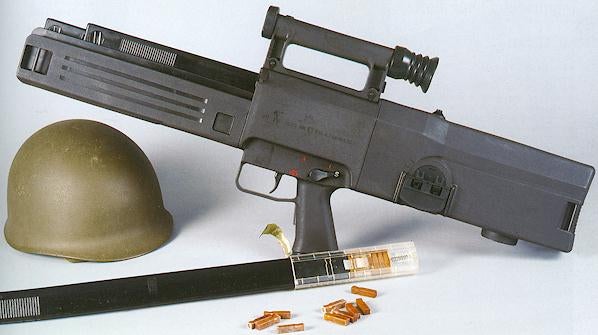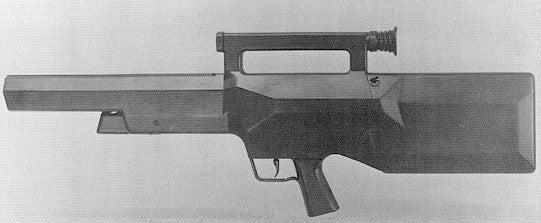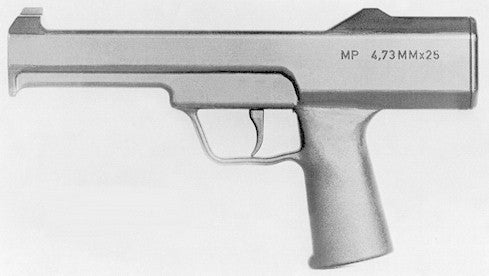Nightcrawler
Member
Caseless firearms have been around conceptually for awhile. One production example is that Voere (sp?) caseless rifle. However, I think it's a bolt action; caseless weapons really only come into their own in autoloading designs.
The only real attempt to produce a caseless rifle was the Heckler & Koch G11.

HK G11, image courtesy of HKPRO.
However, I don't like the implementation of the G11. A 4.73mm bullet is too small for my tastes, even in a select-fire assault rifle. The idea was to implement super-high-ROF bursts, to try to get multiple rounds on one target. But this negates the advantage of a large magazine. A better idea is to simply chamber your caseless rifle for a more powerful round.
HK also had some other concepts.

HK LMG-11 Light Machine Gun

HK G11 PDW machine pistol
The biggest advantage of caseless ammunition, as I see it, is reduced weight and bulk. With caseless ammo, you could get a full-powered 7.62mm cartridge that weighed less than a current 5.56mm cartridge. A 5.56mm caseless cartridge would be smaller still, allowing soldiers (especialy SpecOps types that are away from resupply for long periods of time) to more easily carry ammunition.
The downsides are apparent, too. Overheating and fouling need to be addressed, and a different manual of arms would be required. After all, you need to be able to safely clear the weapon and verify that the chamber is empty.
So, what do you think? Is caseless ammunition the wave of the future? Will it replace traditional metallic cartridges as the "standard" in future? Why or why not?
One thing that's been puzzling me. Can anybody think of how to make a caseless handgun that operates any different than a regular one? I mean, let's say you've got your 9mm Caseless pistol round. You have a magazine load of it, that you insert into the pistol. Then what? Would the thing still bascially be breech-locked or blowback operated? All of those complicated loading mechanisms you see in the G11 rifle simply wouldn't FIT in a regular sized handgun. Note that the G11 PDW is about the side of an MP5K, which would be hard to carry in an IWB holster.
Any ideas on that?
The only real attempt to produce a caseless rifle was the Heckler & Koch G11.

HK G11, image courtesy of HKPRO.
However, I don't like the implementation of the G11. A 4.73mm bullet is too small for my tastes, even in a select-fire assault rifle. The idea was to implement super-high-ROF bursts, to try to get multiple rounds on one target. But this negates the advantage of a large magazine. A better idea is to simply chamber your caseless rifle for a more powerful round.
HK also had some other concepts.

HK LMG-11 Light Machine Gun

HK G11 PDW machine pistol
The biggest advantage of caseless ammunition, as I see it, is reduced weight and bulk. With caseless ammo, you could get a full-powered 7.62mm cartridge that weighed less than a current 5.56mm cartridge. A 5.56mm caseless cartridge would be smaller still, allowing soldiers (especialy SpecOps types that are away from resupply for long periods of time) to more easily carry ammunition.
The downsides are apparent, too. Overheating and fouling need to be addressed, and a different manual of arms would be required. After all, you need to be able to safely clear the weapon and verify that the chamber is empty.
So, what do you think? Is caseless ammunition the wave of the future? Will it replace traditional metallic cartridges as the "standard" in future? Why or why not?
One thing that's been puzzling me. Can anybody think of how to make a caseless handgun that operates any different than a regular one? I mean, let's say you've got your 9mm Caseless pistol round. You have a magazine load of it, that you insert into the pistol. Then what? Would the thing still bascially be breech-locked or blowback operated? All of those complicated loading mechanisms you see in the G11 rifle simply wouldn't FIT in a regular sized handgun. Note that the G11 PDW is about the side of an MP5K, which would be hard to carry in an IWB holster.
Any ideas on that?


 , the pistol/rifle/shotgun is one of the few devices completely untouched by the trend towards computerization. A gun is really quite refreshingly simple...
, the pistol/rifle/shotgun is one of the few devices completely untouched by the trend towards computerization. A gun is really quite refreshingly simple... 